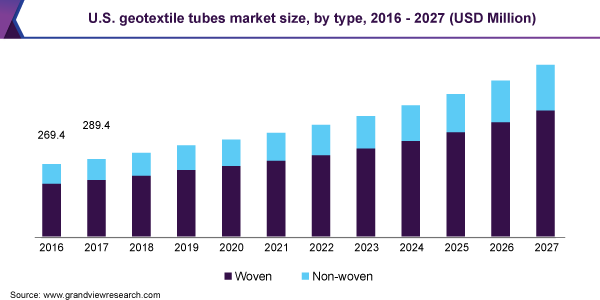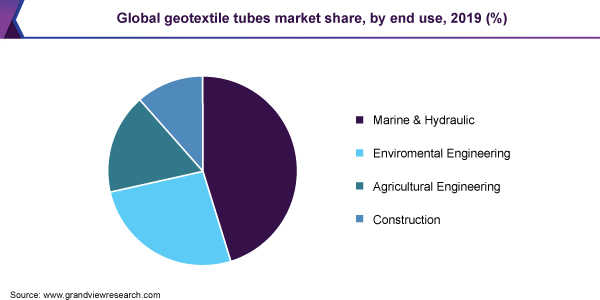- Home
- »
- Specialty Glass, Ceramic & Fiber
- »
-
Geotextile Tubes Market Size, Share Report, 2020-2027GVR Report cover
![Geotextile Tubes Market Size, Share & Trends Report]()
Geotextile Tubes Market Size, Share & Trends Analysis Report By Type (Woven, Nonwoven), By End Use (Marine & Hydraulic, Environmental Engineering, Construction), By Region, And Segment Forecasts, 2020 - 2027
- Report ID: GVR-4-68038-710-0
- Number of Report Pages: 104
- Format: PDF, Horizon Databook
- Historical Range: 2016 - 2018
- Forecast Period: 2020 - 2027
- Industry: Advanced Materials
Report Overview
The global geotextile tubes market size was valued at USD 2.33 billion in 2019 and is expected to grow at a compound annual growth rate (CAGR) of 9.5% from 2020 to 2027. Growing regulatory support adoption of geotextile tubes for preventing the land and soil erosion caused due to river water and coastal waves are expected to drive the product demand. Stringent regulatory framework and environmental concerns are expected to play a critical role in shaping the industry in the near future. Government regulations and policies that govern water treatment for industrial as well as domestic wastewater are anticipated to positively impact the water treatment industry, thereby, driving the demand for product in wastewater treatment.

In the U.S., the market is dominated by woven geotextiles owing to its superior flexibility and dimensional stability under a high-pressure environment. As a result, the tubes made from synthetic materials such as polypropylene and polyethylene, and polyester are being progressively utilized to prevent coastal erosion.
Dykes, bunds, breakwater, groins, revetment, and seawalls are some of the traditional structures that are used to prevent coastal erosion. However, the construction of these structures requires huge investments and time. Geotextile tubes have emerged as an effective alternative to these structures owing to their ease of installation, low maintenance, and low-cost property.
Implementation of stringent regulations to prevent water pollution and discharge of wastewater in the water bodies is anticipated to propel market growth over the forecast period. Geotextile tubes are witnessing growing adoption in the sludge dewatering application to reduce the sludge volume to be treated thereby, reducing the overall cost required for sludge treatment.
Depleting petroleum feedstock has contributed to an increase in the prices of synthetic fibers used for the production of geotextiles. Thus, manufacturers have undertaken extensive R&D activities to develop bio-based raw materials. Furthermore, manufacturers are focusing on utilizing natural fiber such as jute and coir for the production to reduce the raw material costs.
Type Insights
The woven geotextile tubes segment is emerged as the leading segment in 2019 with a market share of 76.6% owing to its wide-ranging utilization to prevent coastal erosion application. Woven geotextile tubes exhibit superior mechanical strength and structural stability against the coastal waves and help in dissipating the erosional forces.
Woven geotextiles are manufactured by weaving together of synthetic and natural fibers to form a fabric with excellent mechanical strength and a porous structure. As a result, these fabrics are widely used in road construction and soil stabilization applications. Woven geotextiles are also witnessing rising adoption in wastewater treatment applications.
Non-woven geotextiles are produced by the bonding of fibers by way of chemical bonding, heat, needle punching as opposed to weaving. These fabrics generally used in filters or separation applications owing to superior porosity. Furthermore, they are used as supporting material to woven geotextiles in various structural applications.
The nonwoven geotextile tubes segment is projected to expand at a CAGR of 9.1% over the projected period. These tubes are widely used in the dewatering of sludge, mining residue on account of their highly porous structure. The use of these tubes delivers a significant reduction in waste volume thereby reducing the treatment and transportation costs.
End-use Insights
The marine and hydraulic end-use segment led the product market with a share of 45.3% in 2019. Growing investment in the protection of coastal areas and beach rejuvenation activities is the primary factor driving the segment growth. Furthermore, increasing product use in the construction of flood mitigation structures is having a positive impact on segment growth.
Technological advancements in manufacturing technology such as the use of recycled and naturally derived fibers coupled with the use of various additives to improve the UV resistance and to reduce the fouling potential are also expected to have a favorable impact on the market growth.

The environmental engineering segment is projected to grow at a significant pace over the forecast period. Globally, there has been a growing focus on maximizing the recycling of municipal and industrial wastewater discharge thereby driving the demand for the sludge dewatering applications.
Growing investment in the construction of the marine structure such as ports, bridges, and tunnels is driving the demand for the product in the construction segment. Furthermore, the strict implementation of aquaculture waste discharge rules is projected to drive the growth of the agricultural engineering segment.
Regional Insights
Europe accounted for about 25.6% of the overall market for geotextile tubes. Europe has been at the forefront of undertaking various initiatives to reduce coastal erosion activities. Germany and France are some of the leading countries that are using the product as an effective low-cost alternative to the traditional coastal protection structures.
The product market within the UAE is expected to expand at a CAGR of 8.7% over the forecast period. Growing land reclamation activities are expected to provide a major boost in the product demand within the county. Moreover, rising investment in various development of marine structures is projected favorably impact the market.
Asia Pacific was the largest market for geotextile tubes in 2019. The region witnesses the periodic occurrence of hurricanes and floods. As a result, the countries in the region are making significant investments in coastal protection structure to prevent coastal erosion and seawater ingress thereby, driving the product demand.
The countries Central and South America region including Brazil, Argentina, and Chile are endowed with long coastlines and derive significant revenues from beach tourism. These countries are anticipated to make a robust investment in coastal protection activities to prevent coastal erosion thereby driving the product demand.
Key Companies & Market Share Insights
The key players are making significant investments in R&D activities to improve product durability and antifouling properties. They are actively offering technical support during and after product installation to generate goodwill and increase their market footprint. Additionally, they are also focusing on widening their distribution network and geographical presence. The companies compete based on product innovation, distribution networks, and technical services. Moreover, these players are increasing the use of recycled and natural fibers to reduce their environmental footprint. Some of the prominent players in the geotextile tubes market include:
-
Koninklijke Tencate
-
Huesker
-
Geofabrics Australasia Pty Ltd.
-
Officine Maccaferri
Geotextile Tubes Market Report Scope
Report Attribute
Details
Market size value in 2020
USD 2.5 Billion
Market size volume in 2020
1,652.7 Million Square Meters
Revenue forecast in 2027
USD 4.8 Billion
Volume forecast in 2027
2,851.9 Million Square Meters
Growth Rate
CAGR of 9.5% (revenue-based) from 2020 to 2027
Base year for estimation
2019
Historical data
2016 - 2018
Forecast period
2020 - 2027
Quantitative units
Volume in Million Square Meters, Revenue in USD Million and CAGR from 2020 to 2027
Report coverage
Revenue forecast, company ranking, competitive landscape, growth factors, and trends
Segments covered
Type, end-use, region
Regional scope
North America; Europe; Asia Pacific; Central & South America; Middle East & Africa
Country scope
U.S.; Canada; Mexico; Germany; U.K.; France; Italy; Spain; China; Japan; India; Australia; Brazil; Saudi Arabia; UAE
Key companies profiled
Koninklijke Tencate; Huesker; Geofabrics Australasia Pty Ltd.; Officine Maccaferri
Customization scope
Free report customization (equivalent up to 8 analysts working days) with purchase. Addition or alteration to country, regional & segment scope.
Pricing and purchase options
Avail customized purchase options to meet your exact research needs. Explore purchase options
Segments Covered in the ReportThis report forecasts volume and revenue growth at global, regional, and country levels and provides an analysis of the latest industry trends in each of the sub-segments from 2016 to 2027. For the purpose of this study, Grand View Research has segmented the global geotextile tubes market report on the basis of type, end-use, and region:
-
Type Outlook (Volume, Million Square Meters; Revenue, USD Million, 2016 - 2027)
-
Woven
-
Nonwoven
-
-
End-use Outlook (Volume, Million Square Meters; Revenue, USD Million, 2016 - 2027)
-
Marine & Hydraulic
-
Environmental Engineering
-
Agricultural Engineering
-
Construction
-
-
Regional Outlook (Volume, Million Square Meters; Revenue, USD Million, 2016 - 2027)
-
North America
-
The U.S.
-
Canada
-
Mexico
-
-
Europe
-
Germany
-
The U.K.
-
France
-
Italy
-
Spain
-
-
Asia Pacific
-
China
-
Japan
-
India
-
Australia
-
-
Central & South America (CSA)
-
Brazil
-
-
Middle East & Africa (MEA)
-
Saudi Arabia
-
UAE
-
-
Frequently Asked Questions About This Report
b. The global geotextile tubes market size was estimated at USD 2,332.1 million in 2019 and is expected to reach USD 2,514.3 million in 2020.
b. The geotextile tubes market is expected to grow at a compound annual growth rate of 9.5% from 2020 to 2027 to reach USD 4,837.5 million by 2027.
b. The woven geotextiles tubes segment dominated the geotextile tubes market with a share of 71.1% in 2019. This is attributable to its long life cycle and superior performance characteristics.
b. Some of the key players operating in the geotextile tubes market include Bridgestone, Koninklijke Tencate, Naue GmbH & Co. Kg., Huesker, Fibertex Nonwovens, Geofabrics Australasia Pty Ltd., Officine Maccaferri, and Ace Geosynthetics.
b. The key factors that are driving the geotextile tubes market include growing focus on reducing the extent of coastal erosion, and growing product utilization in sludge dewatering application.
Share this report with your colleague or friend.
![gvr icn]()
NEED A CUSTOM REPORT?
We can customize every report - free of charge - including purchasing stand-alone sections or country-level reports, as well as offer affordable discounts for start-ups & universities. Contact us now
![Certified Icon]()
We are GDPR and CCPA compliant! Your transaction & personal information is safe and secure. For more details, please read our privacy policy.
We are committed towards customer satisfaction, and quality service.
"The quality of research they have done for us has been excellent."





